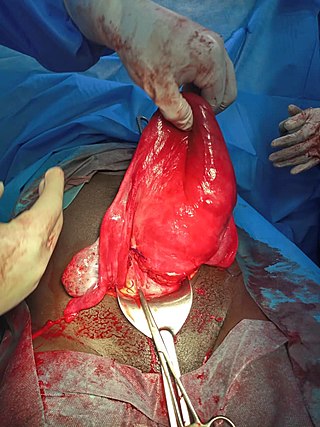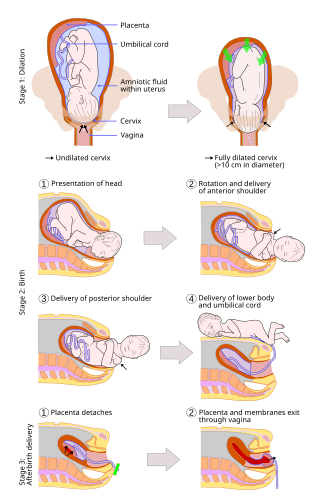Related Research Articles
Obstetrics is the field of study concentrated on pregnancy, childbirth and the postpartum period. As a medical specialty, obstetrics is combined with gynecology under the discipline known as obstetrics and gynecology (OB/GYN), which is a surgical field.

Childbirth, also known as labour, parturition and delivery, is the completion of pregnancy where one or more babies exits the internal environment of the mother via vaginal delivery or caesarean section. In 2019, there were about 140.11 million human births globally. In the developed countries, most deliveries occur in hospitals, while in the developing countries most are home births.

Maternal death or maternal mortality is defined in slightly different ways by several different health organizations. The World Health Organization (WHO) defines maternal death as the death of a pregnant mother due to complications related to pregnancy, underlying conditions worsened by the pregnancy or management of these conditions. This can occur either while she is pregnant or within six weeks of resolution of the pregnancy. The CDC definition of pregnancy-related deaths extends the period of consideration to include one year from the resolution of the pregnancy. Pregnancy associated death, as defined by the American College of Obstetricians and Gynecologists (ACOG), are all deaths occurring within one year of a pregnancy resolution. Identification of pregnancy associated deaths is important for deciding whether or not the pregnancy was a direct or indirect contributing cause of the death.

Misoprostol is a synthetic prostaglandin medication used to prevent and treat stomach and duodenal ulcers, induce labor, cause an abortion, and treat postpartum bleeding due to poor contraction of the uterus. It is taken by mouth when used to prevent gastric ulcers in people taking nonsteroidal anti-inflammatory drugs (NSAID). For abortions it is used by itself or in conjunction with mifepristone or methotrexate. By itself, effectiveness for abortion is between 66% and 90%. For labor induction or abortion, it is taken by mouth, dissolved in the mouth, or placed in the vagina. For postpartum bleeding it may also be used rectally.

Placental abruption is when the placenta separates early from the uterus, in other words separates before childbirth. It occurs most commonly around 25 weeks of pregnancy. Symptoms may include vaginal bleeding, lower abdominal pain, and dangerously low blood pressure. Complications for the mother can include disseminated intravascular coagulopathy and kidney failure. Complications for the baby can include fetal distress, low birthweight, preterm delivery, and stillbirth.
Antepartum bleeding, also known as antepartum haemorrhage (APH) or prepartum hemorrhage, is genital bleeding during pregnancy after the 28th week of pregnancy up to delivery.
Obstetrical bleeding is bleeding in pregnancy that occurs before, during, or after childbirth. Bleeding before childbirth is that which occurs after 24 weeks of pregnancy. Bleeding may be vaginal or less commonly into the abdominal cavity. Bleeding which occurs before 24 weeks is known as early pregnancy bleeding.

Uterine rupture is when the muscular wall of the uterus tears during pregnancy or childbirth. Symptoms, while classically including increased pain, vaginal bleeding, or a change in contractions, are not always present. Disability or death of the mother or baby may result.

Uterine artery embolization is a procedure in which an interventional radiologist uses a catheter to deliver small particles that block the blood supply to the uterine body. The procedure is primarily done for the treatment of uterine fibroids and adenomyosis. Since uterine fibroids are the most common indication, it is also often referred to as uterine fibroid embolization. Compared to surgical treatment for fibroids such as a hysterectomy, in which a woman's uterus is removed, uterine artery embolization may be beneficial in women who wish to retain their uterus. Other reasons for uterine artery embolization are postpartum hemorrhage and uterine arteriovenous malformations.

The International Federation of Gynaecology and Obstetrics, usually just FIGO ("fee'go") as the acronym of its French name Fédération Internationale de Gynécologie et d'Obstétrique, is a worldwide non-governmental organisation representing obstetricians and gynaecologists in over one hundred territories. It was founded on 26 July 1954 in Geneva, Switzerland, to "promote the well-being of women and to raise the standard of practice in obstetrics and gynaecology". Membership is currently composed of 132 professional societies of obstetricians and gynaecologists worldwide.

Placenta accreta occurs when all or part of the placenta attaches abnormally to the myometrium. Three grades of abnormal placental attachment are defined according to the depth of attachment and invasion into the muscular layers of the uterus:
- Accreta – chorionic villi attached to the myometrium, rather than being restricted within the decidua basalis.
- Increta – chorionic villi invaded into the myometrium.
- Percreta – chorionic villi invaded through the perimetrium.

Balloon tamponade usually refers to the use of balloons inserted into the esophagus, stomach or uterus, and inflated to alleviate or stop refractory bleeding.

Uterine atony is the failure of the uterus to contract adequately following delivery. Contraction of the uterine muscles during labor compresses the blood vessels and slows flow, which helps prevent hemorrhage and facilitates coagulation. Therefore, a lack of uterine muscle contraction can lead to an acute hemorrhage, as the vasculature is not being sufficiently compressed. Uterine atony is the most common cause of postpartum hemorrhage, which is an emergency and potential cause of fatality. Across the globe, postpartum hemorrhage is among the top five causes of maternal death. Recognition of the warning signs of uterine atony in the setting of extensive postpartum bleeding should initiate interventions aimed at regaining stable uterine contraction.

Postpartum bleeding or postpartum hemorrhage (PPH) is often defined as the loss of more than 500 ml or 1,000 ml of blood following childbirth. Some have added the requirement that there also be signs or symptoms of low blood volume for the condition to exist. Signs and symptoms may initially include: an increased heart rate, feeling faint upon standing, and an increased breathing rate. As more blood is lost, the patient may feel cold, blood pressure may drop, and they may become restless or unconscious. The condition can occur up to six weeks following delivery.

A vaginal delivery is the birth of offspring in mammals through the vagina. It is the most common method of childbirth worldwide. It is considered the preferred method of delivery, with lower morbidity and mortality than caesarean sections (C-sections).

The non-pneumatic anti-shock garment (NASG) is a low-technology first-aid device used to treat hypovolemic shock. Its efficacy for reducing maternal deaths due to obstetrical hemorrhage is being researched. Obstetrical hemorrhage is heavy bleeding of a woman during or shortly after a pregnancy. Current estimates suggest over 300,000 women die from obstetrical hemorrhage every year with 99% of cases occurring in developing countries; many of these deaths are preventable. Many women in resource-poor settings deliver far from health-care facilities. Once hemorrhage has been identified, many women die before reaching or receiving adequate treatment. The NASG can be used to keep women alive until they can get the treatment they need.
A uterotonic, also known as an oxytocic or ecbolic, is a type of medication used to induce contraction or greater tonicity of the uterus. Uterotonics are used both to induce labor and to reduce postpartum hemorrhage.

The B-Lynch suture or B-Lynch procedure is a form of compression suture used in obstetrics. It is used to mechanically compress an atonic uterus in the face of severe postpartum hemorrhage. It was developed by Christopher B-Lynch, a consultant obstetrician and gynaecological surgeon based at Milton Keynes General Hospital, Milton Keynes, Buckinghamshire, England. B-Lynch was born in 1947 in Sierra Leone with the birth name of Christopher Balogun-Lynch.
Sayeba Akhter is a Bangladeshi physician who has dedicated her career to eliminating obstetric fistula. She is an executive member of the International Society of Obstetric Fistula Surgeons and has previously served as the president of the Obstetrics and Gynaecology Society of Bangladesh. She leads two charities, in Dhaka and Gaibandha, which focus on the education of underprivileged girls.
Uterine balloon tamponade (UBT) is a non-surgical method of treating refractory postpartum hemorrhage. Once postpartum hemorrhage has been identified and medical management given, UBT may be employed to tamponade uterine bleeding without the need to pursue operative intervention. Numerous studies have supported the efficacy of UBT as a means of managing refractory postpartum hemorrhage. The International Federation of Gynecology and Obstetrics (FIGO) and the World Health Organization (WHO) recommend UBT as second-line treatment for severe postpartum hemorrhage.
References
- 1 2 "Bakri® Postpartum Balloon with Rapid Instillation Components". Cook Medical Products.
- ↑ Abouzahr, C (1998). "Antepartum and postpartum haemorrhage". In Murray, Christopher J. L.; Lopez, Alan D. (eds.). Health Dimensions of Sex and Reproduction: The Global Burden of Sexually Transmitted Diseases, HIV, Maternal Conditions, Perinatal Disorders, and Congenital Anomalies. Harvard School of Public Health. pp. 172–174. ISBN 978-0-674-38335-7.
- ↑ Grönvall, Maiju; Tikkanen, Minna; Tallberg, Erika; Paavonen, Jorma; Stefanovic, Vedran (2013). "Use of Bakri balloon tamponade in the treatment of postpartum hemorrhage: A series of 50 cases from a tertiary teaching hospital". Acta Obstetricia et Gynecologica Scandinavica. 92 (4): 433–438. doi:10.1111/j.1600-0412.2012.01531.x. PMID 22913383. S2CID 2851504.
- ↑ Diemert, Anke; Ortmeyer, Gerhard; Hollwitz, Bettina; Lotz, Manuela; Somville, Thierry; Glosemeyer, Peter; Diehl, Werner; Hecher, Kurt (2012). "The combination of intrauterine balloon tamponade and the B-Lynch procedure for the treatment of severe postpartum hemorrhage". American Journal of Obstetrics and Gynecology. 206 (1): 65.e1–65.e4. doi:10.1016/j.ajog.2011.07.041. PMID 22000893.
- ↑ Xiao, C.; Wang, Y.; Zhang, N.; Sun, G. Q. (2023). "Bakri Balloon for Treatment of Postpartum Hemorrhage: A Real-World 2016–2020 Study in 279 Women from a Single Center". Medical Science Monitor. 29: e938823-1-e938823-9. doi:10.12659/MSM.938823. PMC 9987168 . PMID 36855288.
- ↑ Lalonde, André (May 2012). "Prevention and treatment of postpartum hemorrhage in low-resource settings". International Journal of Gynecology & Obstetrics. 117 (2): 108–118. doi:10.1016/j.ijgo.2012.03.001. PMID 22502595. S2CID 34206676.
- ↑ WHO recommendation on uterine balloon tamponade for the treatment of postpartum haemorrhage. World Health Organization. 2021. hdl: 10665/340796 . ISBN 978-92-4-001384-1.[ page needed ]